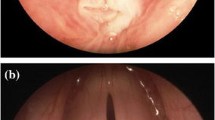Abstract
Purpose
Validation of a classification to stratify presbylarynx into three types.
Methods
Evaluate the reproducibility of this classification. 30 video recordings of rigid laryngostroboscopies were presented to 20 otorhinolaryngologists from five tertiary hospitals: 10 residents and 10 specialists. Specialists with different differentiations were included.
Results
Among 1200 evaluations performed (30 video recordings × 20 raters, twice), average intra-rater agreement rate was 0.847 (p < 0.001). The average inter-rater reliability was 0.67 ± 0.179 on the first evaluation, and 0.691 ± 0.131 on the second evaluation.
Conclusions
This study presented the validation of a classification that allows stratifying laryngeal endoscopic signs in elderly patients with presbyphonia. We believe that this classification will enrich the diagnostic protocol of the aging voice and will improve the documentation of treatment outcomes.

Similar content being viewed by others

References
Takano S, Kimura M, Nito T, Imagawa H, Sakakibara K, Tayama N (2010) Clinical analysis of presbylarynx-vocal fold atrophy in the elderly individuals. Auris Nasus Larynx 37:461–467
Lundy DS, Silva C, Casiano RR, Lu FL, Xue JW (1998) Cause of hoarseness in elderly patients. Otolaryngol Head Neck Surg 118:481–485
Kendall K (2007) Presbyphonia: a review. Curr Opin Otolaryngol Head Neck Surg 15:137–140
Pessin AB, Tavares EL, Gramuglia AC et al (2017) Voice and ageing: clinical, endoscopic and acoustic investigation. Clin Otolaryngol 42:330–335
Pontes P, Brasolotto A, Behlau M (2005) Glottic characteristics and voice complaint in the elderly. J Voice 19:84–94
Santos M, Freitas SV, Sousa CAE, da Silva ÁM (2021) Presbylarynx: stratifying endoscopic signs for future researches. Eur Arch Otorhinolaryngol 278(6):2157–2158
Galluzzi F, Garavello W (2018) The aging voice: a systematic review of presbyphonia. Eur Geriatr Med 9(5):559–570
Santos M, Azevedo S, Sousa F, et al. (2021) Presbylarynx: is it a sign of the health status of the elderly? J Voice. S0892-1997(21)00007-2
Santos M, Freitas SV, Dias D et al (2021) Presbylarynx: does body muscle mass correlate with vocal atrophy? A prospective case control study. Laryngoscope 131(1):E226–E230
Landis JR, Koch GG (1977) The measurement of observer agreement for categorical data. Biometrics 33(1):159–174
Acknowledgements
To Yin Yiu, MD due to her suggestions and manuscript edits.
Funding
The authors declare that they have no financial disclosure to declare.
Author information
Authors and Affiliations
Corresponding author
Ethics declarations
Conflict of interest
The authors declare that they have no conflict of interest.
Ethical approval
All procedures performed in studies involving human participants were in accordance with the ethical standards of the institutional and national research committee and with the 1964 Helsinki declaration and its later amendments or comparable ethical standards.
Informed consent
Informed consent was obtained from all individual participants included in the study.
Additional information
Publisher's Note
Springer Nature remains neutral with regard to jurisdictional claims in published maps and institutional affiliations.
Rights and permissions
Springer Nature or its licensor holds exclusive rights to this article under a publishing agreement with the author(s) or other rightsholder(s); author self-archiving of the accepted manuscript version of this article is solely governed by the terms of such publishing agreement and applicable law.
About this article
Cite this article
Santos, M., Freitas, S.V., Almeida e Sousa, C. et al. Presbylarynx: validation of a classification based on morphological characteristics. Eur Arch Otorhinolaryngol 280, 781–788 (2023). https://doi.org/10.1007/s00405-022-07618-x
Received:
Accepted:
Published:
Issue Date:
DOI: https://doi.org/10.1007/s00405-022-07618-x



